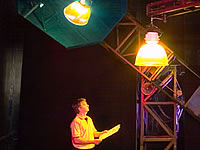

LightLab offers a comprehensive photometric testing service that is summarised in the table below. The variety of samples and breadth of testing is substantial, please contact us if your requirements our outside our mainstream testing services. Our technicians have many years of experience and will help you determine what course of action is necessary whatever your testing needs. Our ultimate goal is to supply you with succinct, accurate and meaningful information.
Information we provide to you takes many forms. Traditional communication of results is in the form of printed test reports. We will supply NATA endorsed reports for those laboratory activities that are covered by our NATA accreditation. Regardless of whether the measurements are covered by our accreditation or not you can rest assured we will perform the test to the same exacting standards. Please refer to our laboratory quality document for further information.
For applicable test types (refer to the table below) we will provide photometric data files. We can generate photometric data in many formats recognized internationally and by all lighting design software:
Additionally, we can provide the photometric data in a number of popular spreadsheet formats. If you require the files in a different format let us know and we will look into it. The charts that appear on our photometric test reports can be issued to you in electronic format for inclusion in your catalogues.
All of our printed test reports can be supplied in an industry standard electronic format. You gain the ease of use of electronic reports, in distribution, publishing and archiving while retaining the security of unambiguous traceability. For more information about our electronic publishing services please contact us.
Photometric data is the raw currency of lighting design. We can put your photometric data to work. With many decades of experience in lighting design and the application of lighting in architecture our designers can create pleasing designs whatever your requirements.
The laboratory operates two photometers, a rotating mirror goniophotometer with an optical path length of 8 metres and an A type goniophotometer with a variable optical path length of 3 metres to 25 metres. The laboratory also operates an 800mm diameter integrating sphere. The equipment is backed by an array of electrical, thermal and colorimetric measurement equipment.
Our standard photometric service is the photometry of luminaires, be they interior luminaires, floodlights, streetlanterns or other light sources. Specialty luminaires such as emergency EXIT signs require additional measurements.
In addition, testing can be performed against the requirements of CIBSE LG3 and the results reported in terms of the appropriate CIBSE category. We can advise changes to your luminaire design to improve the classification.
Reports are electronically published and the charts and diagrams can be published separately. Photometric data files in any of the formats supported by the laboratory will be issued.
Reports are electronically published.
Reports are electronically published.
Reports are electronically published applicable charts and diagrams such as isocandela and isolux diagrams can be published separately.